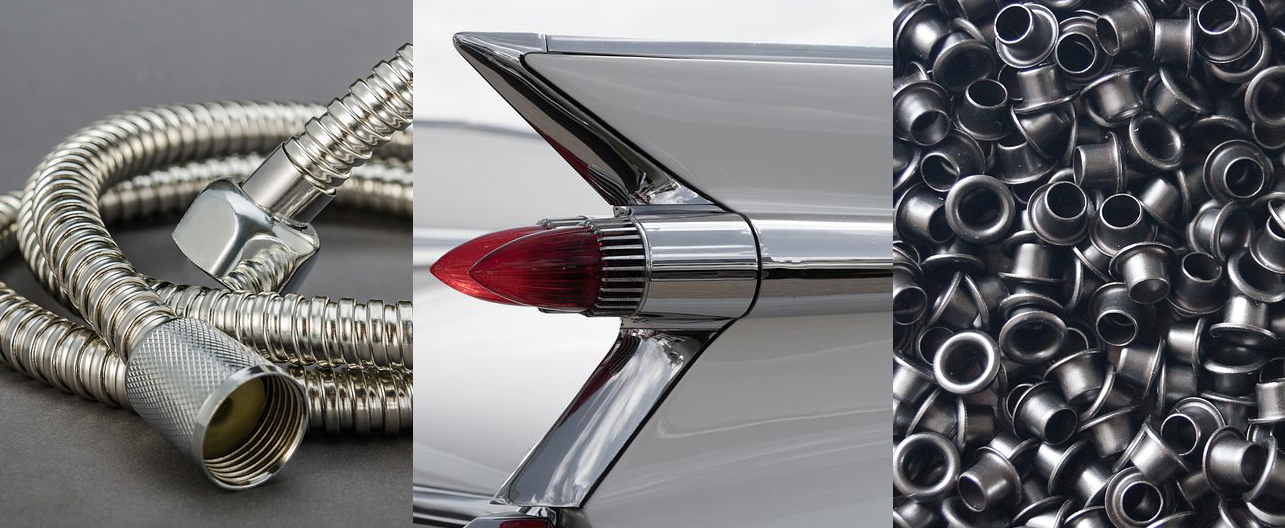Chrome

|
Chrome is short for chromium (Cr), which is a hard grey metal that can be polished to a high sheen. It has a high melting point, and originates from Chromite, which is the only ore in which chromium is found.
In 2020 South Africa was by far the highest global exporter of chromium ore or chromite, followed by Turkey, Pakistan, Kazakhstan and Albania. It is estimated that 99 percent of the world's chromite is found in southern Africa and Zimbabwe, enough to supply the current demand for hundreds of years. Podiform deposits of chromium ore are open-pit mined whilst stratiform deposits and mined underground.
Chromium can be released into the environment by the burning of natural gas, oil, or coal as well as dust pollution from mining and smelting. It does not usually remain in the atmosphere, but is deposited into soil and water where it can change from one form to another and cause damage to marine life. Chrome can be recycled but not easily and chrome plating of aluminium complicates the recycling process for aluminium, though stainless steel scrap metal is generally recycled.
It is an important and indispensable industrial metal because it is hard as well as resistant to corrosion. It is used in the production of stainless and heat resistant (SHR) steels, where often about 18% is chromium, in nonferrous alloys as well as in the creation pigments and chemicals that are used to process leather.
In general its most commonly recognisable use is in kitchen appliances, food processing equipment, medical and dental tools as well as vehicle fittings such as trims and hubcaps. Chromium in super-alloys (high-performance alloys) are stable at high stress-temperatures, as is Chromite which is used in blast furnaces and brick moulds because it retains strength at high temperature.
Chromium is also important for health. Organ meats, mushrooms, wheat germ, and broccoli are good dietary sources of chromium. Insufficient chromium in the body can result in glucose intolerance.
[edit] Related articles on Designing Buildings
- Cast iron.
- Concrete-steel composite structures.
- Constructing steel buildings.
- Corrosion.
- Decorative metal ceilings.
- Failure of metals.
- Galvanised steel.
- Guidance for construction quality management professionals: Structural Steelwork.
- Metal.
- Mesh mould metal.
- Stainless steel.
- Stainless steel vs. galvanised steel.
- Steel.
- Structural steelwork.
- Sustainable materials.
- Types of steel.
- Weathering steel.
- Zinc
Featured articles and news
A five minute introduction.
50th Golden anniversary ECA Edmundson apprentice award
Showcasing the very best electrotechnical and engineering services for half a century.
Welsh government consults on HRBs and reg changes
Seeking feedback on a new regulatory regime and a broad range of issues.
CIOB Client Guide (2nd edition) March 2025
Free download covering statutory dutyholder roles under the Building Safety Act and much more.
AI and automation in 3D modelling and spatial design
Can almost half of design development tasks be automated?
Minister quizzed, as responsibility transfers to MHCLG and BSR publishes new building control guidance.
UK environmental regulations reform 2025
Amid wider new approaches to ensure regulators and regulation support growth.
The maintenance challenge of tenements.
BSRIA Statutory Compliance Inspection Checklist
BG80/2025 now significantly updated to include requirements related to important changes in legislation.
Shortlist for the 2025 Roofscape Design Awards
Talent and innovation showcase announcement from the trussed rafter industry.
OpenUSD possibilities: Look before you leap
Being ready for the OpenUSD solutions set to transform architecture and design.
Global Asbestos Awareness Week 2025
Highlighting the continuing threat to trades persons.
Retrofit of Buildings, a CIOB Technical Publication
Now available in Arabic and Chinese aswell as English.
The context, schemes, standards, roles and relevance of the Building Safety Act.
Retrofit 25 – What's Stopping Us?
Exhibition Opens at The Building Centre.
Types of work to existing buildings
A simple circular economy wiki breakdown with further links.
A threat to the creativity that makes London special.























